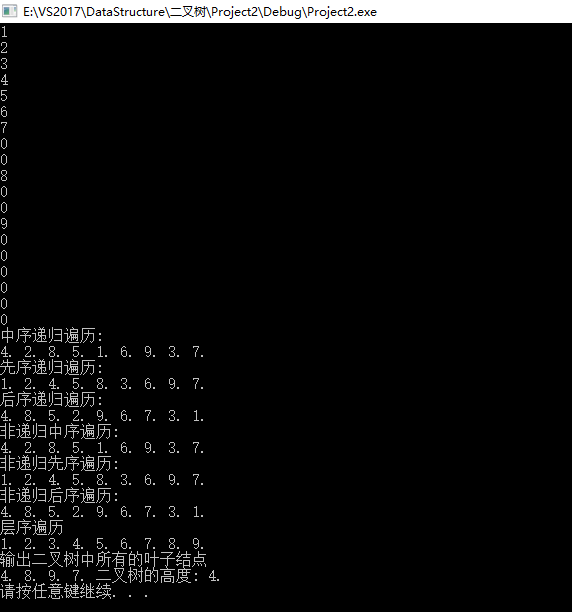二叉树
二叉树的遍历非常重要,一定要熟练掌握。
- 因为二叉树的层序创建,层序遍历均用到了队列结构,二叉树的非递归遍历用到了堆栈结构,这部分的代码在后面单独给出。
- 二叉树的后序非递归遍历有两种实现思路,在下面的代码中只实现了一种。
二叉树的链表结构为:
struct TNode
{
int Data; //节点的数据
struct TNode* Left; //指向左子树
struct TNode* Right; //指向右子树
};
typedef struct TNode* ElementType;
二叉树部分的算法与相关代码实现
#define _CRT_SECURE_NO_WARNINGS
#include<stdio.h>
#include"queue.h"
#include"Stack.h"
#define NoInfo 0 //用0表示没有节点
//struct TNode
//{
// int Data; //节点的数据
// struct TNode* Left; //指向左子树
// struct TNode* Right; //指向右子树
//};
//作用:层序生成二叉树
struct TNode* CreatBinTree()
{
int Data;
struct QNode* Q = CreatQueue(10); //创建空队列
struct TNode* T;
struct TNode* BT;
//建立第一个节点,即根节点
scanf("%d",&Data);
if (Data != NoInfo)
{
//动态分配一个结点单元,并存入数据,同时将该结点地址放入队列
BT = (struct TNode *)malloc(sizeof(struct TNode));
BT->Data = Data;
BT->Left = NULL;
BT->Right = NULL;
AddQ(Q,BT);
}
else
{
return NULL;
}
while (!IsEmpty(Q))
{
T = DeleteQ(Q); //从队列中取出一节点地址
scanf("%d",&Data);
if (Data != NoInfo)
{
//动态分配一个结点单元,并存入数据,同时将该结点地址放入队列
T->Left = (struct TNode *)malloc(sizeof(struct TNode));
T->Left->Data = Data;
T->Left->Left = NULL;
T->Left->Right = NULL;
AddQ(Q, T->Left);
}
else
{
T->Left = NULL;
}
//读入右孩子的数据
scanf("%d", &Data);
if (Data != NoInfo)
{
//动态分配一个结点单元,并存入数据,同时将该结点地址放入队列
T->Right = (struct TNode *)malloc(sizeof(struct TNode));
T->Right->Data = Data;
T->Right->Left = NULL;
T->Right->Right = NULL;
AddQ(Q, T->Right);
}
else
{
T->Right = NULL;
}
} //end while (!IsEmpty(Q))
return BT;
}
//作用:二叉树的递归后序遍历
void PostorderTraversal(struct TNode* BT)
{
if (BT)
{
PostorderTraversal(BT->Left);
PostorderTraversal(BT->Right);
printf("%d. ", BT->Data);
}
}
//作用:二叉树的递归先序遍历
void PreorderTraversal(struct TNode* BT)
{
if (BT)
{
printf("%d. ", BT->Data);
PreorderTraversal(BT->Left);
PreorderTraversal(BT->Right);
}
}
//作用:二叉树的递归中序遍历
void InorderTraversal(struct TNode* BT)
{
if (BT)
{
InorderTraversal(BT->Left);
printf("%d. ", BT->Data);
InorderTraversal(BT->Right);
}
}
//作用:二叉树的非递归中序遍历
void InorderTraversal2(struct TNode* BT)
{
struct TNode* T;
struct SNode* S = CreatStack(10);
T = BT;
while (T || !IsStackEmpty(S))
{
while (T)
{
Push(S, T);
T = T->Left;
}
T = Pop(S);
printf("%d. ",T->Data);
T = T->Right; //转向右子树
}
}
//作用:二叉树的非递归先序遍历
void PreorderTraversal2(struct TNode* BT)
{
struct TNode* T;
struct SNode* S = CreatStack(10);
T = BT;
while (T || !IsStackEmpty(S))
{
while (T)
{
printf("%d. ", T->Data);
Push(S, T);
T = T->Left;
}
T = Pop(S);
T = T->Right; //转向右子树
}
}
//作用:二叉树的非递归后序遍历
//思路1 将先序遍历的算法进行更改
void PostorderTraversal2(struct TNode* BT)
{
struct TNode* T;
struct SNode* S1 = CreatStack(10);
struct SNode* S2 = CreatStack(10);
T = BT;
while (T || !IsStackEmpty(S1))
{
while (T)
{
//printf("%d. ", T->Data);
Push(S2, T); //压入根节点
Push(S1, T);
T = T->Right;
}
T = Pop(S1);
T = T->Left; //转向左子树
}
while (!IsStackEmpty(S2))
{
T = Pop(S2);
printf("%d. ",T->Data);
}
}
//作用:二叉树的非递归后序遍历
//思路2
//ToDo: 参考博客园博客,这里有一个思路2还没有写
void PostorderTraversal3(struct TNode* BT)
{
}
//作用:层序遍历
void LevelorderTraversal(struct TNode* BT)
{
struct QNode* Q;
struct TNode* T;
if (!BT)
{
return; //若是空树,直接返回
}
Q = CreatQueue(10);
AddQ(Q, BT); //首先将根节点入队
while (!IsEmpty(Q))
{
T = DeleteQ(Q);
printf("%d. ", T->Data);
if (T->Left != NULL)
{
AddQ(Q, T->Left);
}
if (T->Right != NULL)
{
AddQ(Q,T->Right);
}
}
}
//作用:输出二叉树的叶子结点
void PreorderPrintLeaves(struct TNode* BT)
{
if (BT)
{
if (BT->Left == NULL && BT->Right == NULL)
{
printf("%d. ", BT->Data);
}
PreorderPrintLeaves(BT->Left);
PreorderPrintLeaves(BT->Right);
}
}
//作用:求二叉树的高度
int GetHeight(struct TNode* BT)
{
int HL;
int HR;
int MaxH;
if (BT) //BT非空进行遍历
{
HL = GetHeight(BT->Left);
HR = GetHeight(BT->Right);
MaxH = HL > HR ? HL : HR;
return MaxH + 1;
}
else
{
return 0;
}
}
int main()
{
struct TNode* BT = CreatBinTree();
printf("中序递归遍历:
");
InorderTraversal(BT);
printf("
先序递归遍历:
");
PreorderTraversal(BT);
printf("
后序递归遍历:
");
PostorderTraversal(BT);
printf("
非递归中序遍历:
");
InorderTraversal2(BT);
printf("
非递归先序遍历:
");
PreorderTraversal2(BT);
printf("
非递归后序遍历:
");
PostorderTraversal2(BT);
printf("
层序遍历
");
LevelorderTraversal(BT);
printf("
输出二叉树中所有的叶子结点
");
PreorderPrintLeaves(BT);
printf("二叉树的高度: %d.
", GetHeight(BT));
system("pause");
return 0;
}
实现链表部分的代码:
queue.h
//二叉树的创建需要队列
//该文件实现队列的一系列操作
#pragma once
#include<stdio.h>
#include<stdbool.h>
#include<stdlib.h>
struct TNode
{
int Data; //节点的数据
struct TNode* Left; //指向左子树
struct TNode* Right; //指向右子树
};
typedef struct TNode* ElementType;
struct QNode
{
ElementType* Data; //存储元素的数组
int Front; //队列的头指针
int Rear; //队列的尾指针
int MaxSize; //队列的最大容量
};
struct QNode* CreatQueue(int MaxSize);
bool IsFull(struct QNode* Q);
bool AddQ(struct QNode* Q, ElementType x);
bool IsEmpty(struct QNode* Q);
ElementType DeleteQ(struct QNode* Q);
queue.c
#include<stdio.h>
#include"queue.h"
//作用:创建一个队列
//参数:队列的大小
struct QNode* CreatQueue(int MaxSize)
{
struct QNode* Q = (struct QNode *)malloc(sizeof(struct QNode));
Q->Data = (ElementType *)malloc(MaxSize * sizeof(int));
Q->Front = Q->Rear = 0;
Q->MaxSize = MaxSize;
return Q;
}
//作用:判断当前队列是否满
//参数:待判断的队列
bool IsFull(struct QNode* Q)
{
return ((Q->Rear + 1) % Q->MaxSize == Q->Front);
}
//作用:向队列中插入元素
//参数:struct QNode* Q 待插入的队列
// int x 待插入的元素
bool AddQ(struct QNode* Q, ElementType x)
{
if (IsFull(Q)) //判断队列是否为空
{
printf("队列满,不能再插入元素
");
return false;
}
else
{
Q->Rear = (Q->Rear + 1) % Q->MaxSize;
Q->Data[Q->Rear] = x;
return true;
}
}
//作用:判断队列是否为空
//参数:
//返回值: true 空
// false 非空
bool IsEmpty(struct QNode* Q)
{
return (Q->Front == Q->Rear);
}
//作用:
//参数:
ElementType DeleteQ(struct QNode* Q)
{
if (IsEmpty(Q))
{
printf("队列为空
");
return NULL;
}
else
{
Q->Front = (Q->Front + 1) % Q->MaxSize;
return Q->Data[Q->Front];
}
}
实现堆栈部分的代码:
Stack.h
#pragma once
#include<stdbool.h>
#include"queue.h"
struct SNode
{
ElementType* Data; //存储元素的数组
int Top; //栈顶指针
int MaxSize; //堆栈的最大容量
};
struct SNode* CreatStack(int MaxSize);
bool IsStackFull(struct SNode* S);
bool Push(struct SNode* S,ElementType x);
bool IsStackEmpty(struct SNode* S);
ElementType Pop(struct SNode* S);
Stack.c
#include"Stack.h"
#include<stdlib.h>
struct SNode* CreatStack(int MaxSize)
{
struct SNode* S = (struct SNode *)malloc(sizeof(struct SNode));
S->Data = (ElementType *)malloc(MaxSize * sizeof(ElementType));
S->MaxSize = MaxSize;
S->Top = -1;
return S;
}
//作用:判断当前堆栈是否满
//返回值: ture 当前堆栈满
// false 当前堆栈非满
bool IsStackFull(struct SNode* S)
{
return S->Top == S->MaxSize - 1;
}
bool Push(struct SNode* S, ElementType x)
{
if (IsStackFull(S))
{
printf("当前堆栈已满.
");
return false;
}
else
{
S->Top = S->Top + 1;
S->Data[S->Top] = x;
return true;
}
}
//作用:判断当前堆栈是否为空
//返回值:true 空
// false 非空
bool IsStackEmpty(struct SNode* S)
{
return S->Top == -1;
}
ElementType Pop(struct SNode* S)
{
if (IsStackEmpty(S))
{
printf("堆栈为空.
");
return false;
}
else
{
return S->Data[(S->Top)--];
}
}
运行结果:
